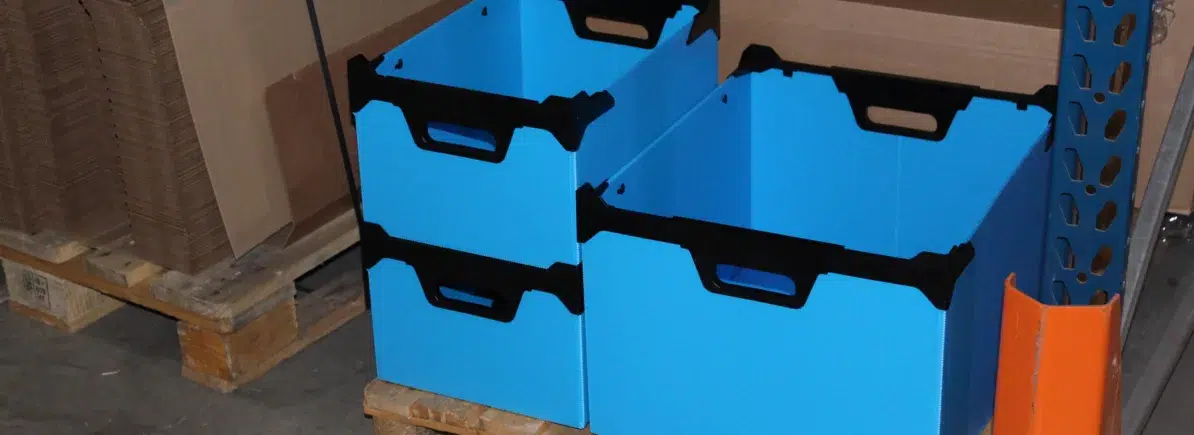How to decide if returnable packaging is right for your business

Manufacturing supply chains can range in size and complexity, often spanning continents and many businesses. But regardless of their setup, packaging, and increasingly returnable packaging, is crucial to their success.
As a result, deciding whether returnable packaging is the right choice for your business is vital.
This guide takes a look at what returnable packaging is, alongside the business and operational characteristics that can make it suited (or unsuited) to your supply chain.
- 1.
-
2.
When you should consider returnable packaging
- 2.1.
- 2.2.
- 2.3.
- 2.4.
- 2.5.
- 3.
- 4.

What is returnable packaging?
Returnable packaging is any box, tote, tray or container that can be used over multiple journeys, rather than a single trip or expendable packaging such as corrugated boxes.
Returnable packaging is typically manufactured from robust, long-lasting materials, including moulded plastics, Correx®, metals, and even timber.
Popular returnable packaging options include Euro containers, Correx® tote boxes, and attached lid containers (ALC), although this can extend to items including pallets. Returnable packaging also often includes inserts to improve performance, including divider sets, layer pads, vacuum-formed trays, foam inserts, and linings.
It is also important not to confuse genuinely returnable packaging with that originally intended for single use but may be reused over multiple journeys, known as opportunistic reuse.

When you should consider returnable packaging
So, how can you tell if switching to or using returnable packaging is right for your business? Well, there are several strong indicators that can help you in making this decision.
You have a returnable supply chain in place
If you already transport going to and, crucially, from your customers and/or suppliers, it can make sense to begin using returnable packaging.
Empty or part-loaded lorries making a return journey to your premises can return your totes or containers without incurring additional costs.
With this in place, there are no additional costs or environmental implications to getting your returnable packaging back to your business for reuse.
However, if it is not easy to return your totes or containers, the additional steps required can often be prohibitive.
You are looking to reduce long-term costs
If your business is looking to take a longer-term view of its costs, returnable packaging can be a great way to make savings.
While returnable containers have a significantly higher upfront unit cost than corrugated boxes, over the course of their usable lifespan, they become much more cost-effective.
As a basic example, if a cardboard box costs 10 pence per unit, the cost per trip (for your packaging alone) is 10 pence. An equivalent returnable tote may cost £10, but over the course of 100 uses, this equates to a 10 pence cost per trip. After 200 uses, this falls to 5 pence, half the cardboard option’s cost.
As this illustrates, using or switching to reusable options can – eventually – result in significant cost savings.
You take a holistic view of your environmental impact
Many businesses take a simplistic view that plastic packaging is bad due to the use of fossil fuels in its manufacture and the difficulty of recycling. In contrast, corrugated cardboard uses renewable materials and is easily recycled.
However, the actual picture is much more nuanced.
The amount of energy required in the transportation of materials, manufacture of a box, and then further transportation and energy involved in recycling (before manufacturing into a box again) can often be more significant than the requirements to produce an equivalent returnable packaging container.
As with costs, reusing packaging can significantly reduce environmental impact when taking a longer-term view. The impact “per trip” becomes considerably less due to eliminating the energy required in continual recycling and remanufacturing.
It should also be noted that most returnable packaging can be recycled at the end of its usable life, although it typically requires specialist facilities.
You need to ensure that damage in transit is prevented
Another area where returnable packaging can play a vital role is reducing transit damage.
Typically more durable and tough to ensure longevity, these properties also inherently improve protection for their contents. Returnable packaging usually provides enhanced protection against moisture, dust, chemicals and adverse weather conditions, too.
Additionally, using dunnage such as dividers, foam, or insert trays prevents the movement of parts or products within their containers during transit, minimising the potential for damage.
You are looking to improve handling, efficiency and safety
Using dividers and inserts inside your returnable packaging has another significant benefit besides reducing damage – improving handling and packing efficiency.
With dedicated cells or compartments within an outer container, it is much quicker and easier for staff to load and unload parts and components from the container. Assembly or production line staff can also see much more quickly how many items remain in a container before running out.
Dividers and inserts also prevent your returnable packaging from being overloaded (as there are only a set number of cells for items to be placed within). This, and other features such as handles, lids or integral pallets, can also improve staff safety as containers do not become too heavy to lift safely.

When returnable packaging may not be right for your business
Although there are considerable benefits to using returnable packaging, it is not suitable for all businesses and applications. If any of the following apply to your business, then single-trip corrugated packaging is likely still your best option.
You have no way to get your returnable packaging back
If you already have transport running between customers and your sites, there is no additional cost (or environmental impact) of having these vehicles return your packaging to you for reuse.
If, however, this is something you need to put in place, the additional expense can often make it prohibitive. This is in addition to increased CO2 emissions negating the environmental benefits associated with reuse.
Similarly, depending on the reliability of your transport provider and your relationships with customers, there is the potential for returnable packaging to suffer damage over time or even go missing. If this occurs, your business faces the costs of repairing or replacing them.
Whilst some maintenance, including cleaning, can be expected, if you fear it is likely that you will be continually needing to replace your containers, any cost savings can be quickly eroded.
You expect customers or end users to recycle them
Whilst returnable packaging is recyclable at the end of its usable lifespan, this usually requires specialist facilities.
As such, if it is likely that your customers will need or be expected to recycle your returnable packaging at the end of its lifespan, this can result in many simply being discarded and ending up in landfill.
You cannot afford the upfront cost
It is inescapable that returnable packaging involves a considerably larger upfront investment than single-trip packaging. And whilst the mid- to long-term costs can be significantly lower, for many businesses this initial cost can be prohibitive.
Many businesses now treat returnable packaging as a capital investment (rather than an ongoing cost) in order to circumvent this issue.
Long term flexibility
Many businesses will have a continually evolving inventory of products that they supply or manufacture. This means that the packaging they use is also adapting and being modified as product lines and ranges change.
However, if you have chosen returnable packaging based on the specification of a product that you are no longer making, it can mean less efficient transit if you continue to use them. It is also considerably more costly to purchase entirely new packaging.
Whilst changing internal dividers and inserts can often negate this issue, if your product range changes considerably over time, returnable packaging may not be the best option.

Summary
Deciding on whether to use returnable packaging at your business can be difficult. And whilst returnable packaging can provide significant cost savings, improved usability, and lessen environmental impact, it is not suitable for every business.
At Macfarlane Packaging, we have vast experience and expertise in supplying both single-trip and returnable packaging. This means that not only can we provide your business with either option, but we can also provide genuinely impartial advice on the best option for your specific application.
So, if you are considering returnable packaging at your business, please speak with one of our team members for assistance.
